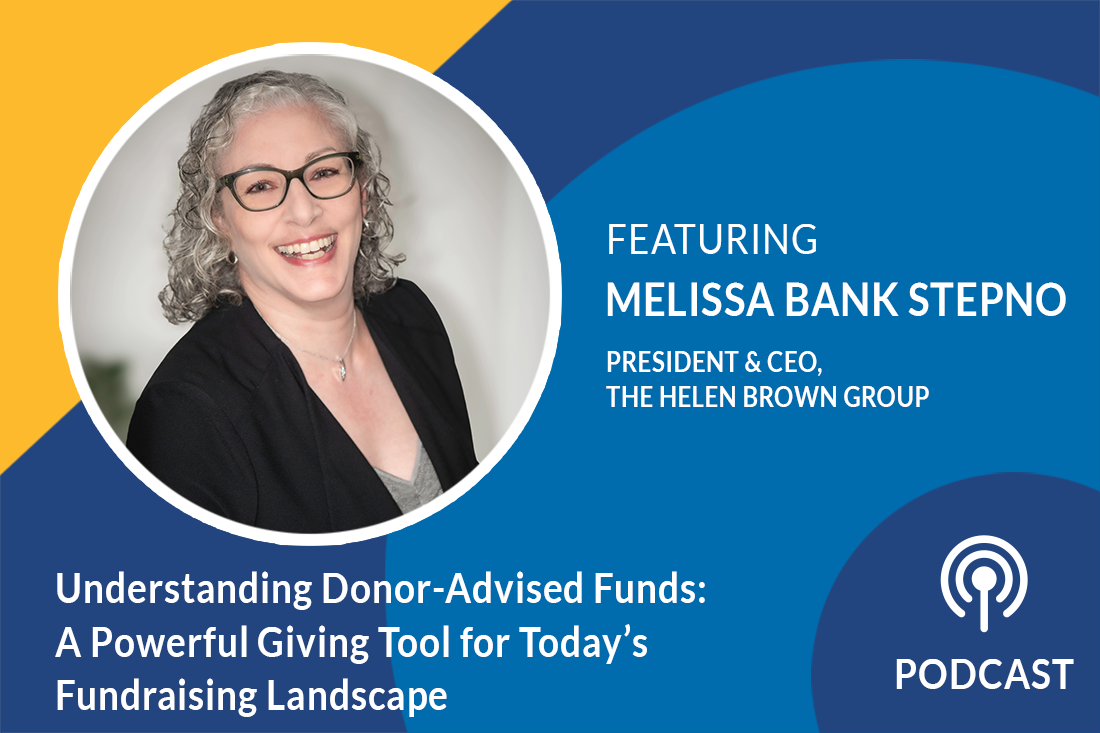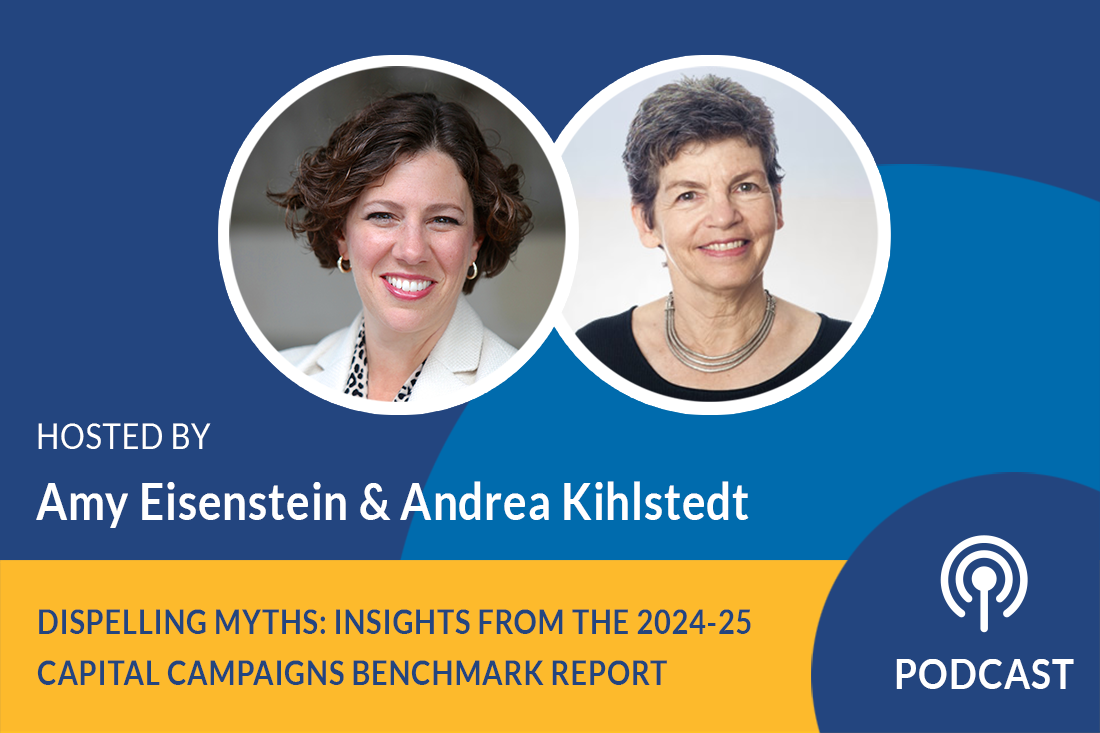Podcast: How to Identify and Prioritize the Top 50 Prospects

Season 2, Episode 47
Campaign experts Amy Eisenstein and Andrea Kihlstedt discuss the importance of developing and maintaining a list of your top 50 prospects and why it’s especially important as you get ready for your capital campaign.
Listen Now:
This podcast is the third of a special Summer Series of conversations on important fundraising topics. Our live webinars will return on September 12, 2022; learn more at ToolkitTalks.com.
Amy Eisenstein:
Hi, I’m Amy Eisenstein, and I’m here with the co-founder of Capital Campaign Pro, my partner in crime, Andrea Kihlstedt. In today’s podcast, Andrea and I are going to talk with you about those all-important top 50 prospects, which really are going to make or break your campaign. If you’ve heard us before, you know that we believe that a very few donors at the top of your gift chart, your campaign pyramid, whatever you want to call it, are going to make or break your campaign, so let’s get into how to find, identify, and prioritize those top 50 prospects. Andrea, what do you want to say about this very important topic?
Andrea Kihlstedt:
Well, I want to start by saying that my mentor in this business, when I was very young in this business, I had a wonderful mentor, and he said to me probably in my first year or two in this business, he said, “Andrea, I can always tell if a development director knows what they’re doing. They know what they’re doing if when I walk into their office and I said, ‘Well, do you have a list of your top 50 prospects?'” He said, “If they pull it out without even blinking an eye,” he said, “then I know what they’re doing, and if they look at me sort of wide-eyed as though, ‘What do you mean top 50 prospects?'”, he said, “Then I know they’re in trouble,” so my belief about the importance of this goes way back in my fundraising career, and this whole long career of mine has only deepened and justified that belief.
Identifying Your Top 50 Donor Prospects
The top 50 prospects are everything, and if you know who they are, if you find out who they are, if you can list them and identify them, you are going to be successful, you are going to do well. Now, the question, Amy, is, how do you go about doing that?
Amy Eisenstein:
Before we get into how you go about finding, identifying and prioritizing those top 50, I do want to acknowledge that there is a time and place in fundraising, and even in capital campaigns for broad-based support for the community to chip in and pitch in at whatever levels they can, but that’s not where you start your campaign, and that really, if you do the math, there is no way to get to your campaign goal whether it’s a million dollars or a hundred million dollars with $50 gifts. There just aren’t enough donors in your community and you could never be successful that way. The fundraising math doesn’t work, so we do need to start, and some people are upset about this concept because it’s elitist and top-heavy and only focusing on the wealthy, but that is the way that these big campaigns work and are successful. Then you will get to the broad base of support. You will do your grassroots-style fundraising later on in the campaign, but let’s start with those top 50 prospects. All right, Andrea, what’s the first thing they need to do?
Andrea Kihlstedt:
Well, I think a great many development director is people who have been in their organizations for quite a while, can simply open up a page and sit down, and off the top of their heads, write down the names of the people they know who should be in that list, right? If you’ve been doing anything in this business, you probably know at least five or 10 or 15 of those people. These are going to be people who have given to your organization generously for a long time. These are going to be people who have extended themselves in one way and another to your organization, who are your closest friends, and who have been willing to give at pretty significant levels over a consistent period of time. Those are going to be the mainstays of your top 50 list, but they’re not the only people on your top 50 list, right?
Amy Eisenstein:
Yeah, so I think you’re right, you’re going to first look to your most loyal and largest donors. I also like to look at loyal donors who are a few levels down. Who has been flying under the radar that have been giving a hundred dollars a year for 10 years, your really loyal donors? Maybe they haven’t given more because you’ve never asked. There is an opportunity here to talk to some of those biggest donors that you already have and ask who else in the community might be really interested in your mission or your cause or your project that you haven’t yet spoken to, but I always start with board members, former board members, active volunteers. Those are really the places to start.
Andrea Kihlstedt:
Right, the people close at home, the people closest to you, and then you can use those people, the people in your inner circle to help you identify the next tier of people. You can actually put them together in a small group and you can show them some lists, say, “Who among these lists of people, who are generous people in our community, should we be involving more effectively in our organization?” It’s amazing what happens when you ask people who are already in your top 50 list to help you identify additional people. They’ll do that, right? Then, of course, once they do that, you can actually ask them to help you open the doors to those people.
Top Prospects Tend to Dig Deeper
Amy Eisenstein:
Now, some people listening are thinking, “Well, our biggest donors give a thousand dollars, so we need campaign gifts of a hundred thousand dollars and up, so we don’t have any of those donors.” But the reality is that frequently, thousand-dollar donors for campaigns give 10 or a hundred times what they have been giving to your annual fund because they dig deep for a project like this. They use assets to make gifts. They go into stock accounts and retirement accounts or use property or other types of assets to make these gifts and they’re not just writing a check for a thousand dollars, so don’t worry too much yet if you don’t have people making very big gifts to your organizations. We do see organizations on a regular basics succeed with those types of donor list. Lots of people will come to us and say, “But we don’t have any big donors.” We say, “Okay, wait a minute. Let’s take a deeper dive.” Are we going to talk about research and wealth screening, Andrea?
Andrea Kihlstedt:
Sure. I mean, as Amy knows, I have mixed feelings about wealth screening, but you should avail yourself of the expertise that is out there, and you can have your list evaluated by a company that does wealth screening. They may well highlight for you people who have been flying under the radar, as Amy says, in your organization, but who have significant capacity and who may have given large gifts to other organizations. It will be helpful for you to know that, and if that’s the case, you should know it.
Then, of course, once you’ve identified those people who you didn’t realize were potential large-gift prospects, then you can take those names to the people who are close to you and say, “Okay, who knows these people? How should we be going about building a relationship with them?” Right? Just because someone shows up on that list doesn’t mean you’re going to ask them for money the next day. Now, the process of finding out who they are and why they give to you at a low level, why they give to you at all is going to be important, inviting them to get acquainted, finding out who else in your organization has a relationship with them, so it is important to do what you can to mine your entire list for the people who might be large on that top 50 list, and you just haven’t identified them yet.
Amy Eisenstein:
When we think about a top 50 list, often people will come to us and say, “Well, we don’t have any donors or big donors, so let’s look out there.” We’ve already talked about looking at your inner circle first, so 40 of the people need to be current donors to your organization, people who are involved in some way, who give, hopefully a few of them at least are board members, maybe volunteers, but these are your biggest donors, your most loyal donors. Then you might have space for 10 on this list of 50 of other people in the community who you have reason to believe might realistically get involved in your cause for this one-time special project. Maybe they aren’t donors yet, but they are philanthropists in the community, and for this type of special project, they might get involved. How much value you can put in that until you’ve spoken with them the first time is limited, but if you think that half of your list is going to come from outside, you need to go back and take a deeper dive into those that are already supporting your organization.
Why 50 and not 20?
Andrea Kihlstedt:
Amy, it’s interesting. We talk about a top 50 list, but if you look at the capital campaign gift range chart for any campaign, the bulk of the campaign, more than 50% often comes from 20 gifts, let’s say, 15 or 20 gifts, not 50 gifts, so why do we have 50 gifts, right? Why do we talk about 50 gifts? Well, one of the reasons —
Amy Eisenstein:
50 prospects. Well, we’re talking about 50 prospects, right?
Andrea Kihlstedt:
… 50 prospects. Exactly, yes. We’re talking about 50 prospect because you should always, of course, start by looking inside, but you should always be looking outside as well. As Amy said, of some of those people, you’re looking at outside, some of them aren’t going to be interested in you at all, some of them are going to be, but it’s an important process, so you should always be working on building a larger list than the people who will actually end up giving you the top 20 gifts for your campaign.
Amy Eisenstein:
Right, you need at least two to three prospects for every gift that you need for your campaign, so while we’re looking for a top 20 gifts to get you halfway to your goal or more, you’re going to start with a list of 50 prospective donors. Some of them will give it lower levels, a few of them won’t give it all, most of them, hopefully, will give something, and some of them will give those the biggest gifts that you need for your campaign. I think that’s the critical takeaway. Anything else?
Andrea Kihlstedt:
Yeah, I started this with a story about my mentor in this business who thought it was so important that people be able to identify their top 50 gifts. Let me end it with a story, too. Years ago, I worked with someone who was the head fundraiser for a hospital, and just out of curiosity, his name was Jay. He’s long gone. But I said to him, “Jay, do you know who your top 50 donors are?” Right, I was testing him, I was trying this out, right? Well, Jay pulled out at the time, I don’t know, what he had what was called then a Filofax, some kind of a book, a datebook-y kind of thing. He turned to the end of it, I was so impressed with this, he turned to the end of it, and in a page and the end of that book, he had his top 50 donor list. On that top 50 donor list, he had for each person their birthdays, the name of their spouses, the names of their children, other information that he would want, and every day he would review that list in the back of his datebook —
Amy Eisenstein:
Wow.
Andrea Kihlstedt:
… so that he would know how to reach out to them. I mean, it was a fundamental way in which he ran not just his development work, but he ran his life in development. He was, as you might imagine, incredibly successful.
Amy Eisenstein:
That is an impressive story and a great reminder of how we should be. I think that those two stories, but remember, we’ll be testing you when you call us. We want to know, do you have a sense of who your top 50 prospects are? As you think about your campaign, as you prepare for a campaign, as you go into a feasibility study, whether you’re working with us at Capital Campaign Pro or anybody else, they’re going to ask you, we’re going to ask you, “Who are your top 50 prospects?”
It Takes Time to Build Your Top 50 List
Listen, we don’t expect you to come up with the list in an hour. I mean, that is unrealistic. It does take time and thought and discussion to build this list, so while Andrea said that if you can whip it out from your desk or print it off in an instant, it doesn’t mean that it hasn’t taken you weeks or months to compile, and so I don’t want you to think that in the next hour, you need to be compiling your top list of 50 prospects. You’re going to meet with people. You’re going to meet with committees. You’re going to discuss your donors. You’re going to think about it. You’re going to crosscheck it against your donor research and your prospect research and your wealth screening. You’re going to review your lists with committees to come up with your top 50 prospects, so this isn’t something that happens in 15 minutes, or an hour, but you should have a list of your top 50 prospects.
Andrea Kihlstedt:
Amy, as you were talking about that, I just want to say that while we talk about a top 50 list, what we’re really talking about is a practice, an ongoing practice, because that top 50 list is not static, right? It’s going to change. People are going to come onto it. People are going to go off it. People are going to move out of the community. They’re going to die. All kinds of things are going to happen. This is not a static once-and-done list, so it’s really a development practice that if you are in this business, staying on top of developing, asking people for help, creating the list of the donors who are going to be most important to your organization is something that should be top of mind as it was for my friend Jay long ago at his hospital. The top 50 is just a shorthand way of talking about that kind of practice.
Amy Eisenstein:
Excellent, which is an important practice if you’re going into a capital campaign, especially. Andrea, thank you for those stories and sharing your wisdom as always. For those of you that are listening, if you want to learn even more about identifying your top prospects, we do have lots of free campaign resources and blog posts on this topic on Capital Campaign Pro website. I hope you’ll visit the website for looking for more resources and information.
If you’re getting ready for a campaign and want help developing your top 50 list or your campaign plan and strategy, I hope you’ll sign up for a free strategy session to see if we might be able to help you with your campaign. Thanks for joining us and we’ll see you next week. Bye for now.



Ok, my scenario is this …
Currently in feasibility study, we have one board member who has given 5 figures for seed money; one family foundation who gave 5 figures for seed money. That’s it. Nada. No additional seed money for cc costs at this time.
Very ambitious working goal of $30M. Land must be identified.
Feasibility study will indicate who may support on 6 and 7 figure levels to reach minimum 75% goal. If that is not discerned the writing is on the wall.
Thoughts?
If you are in the middle of a feasibility study, there’s not much for you to do other than to wait for the results. As you say, that will put the “writing on the wall” at least for the big project you have in mind. If the results are disappointing you may have to scale back your plans or delay while you do more to build your donor base.
I wish I could say that there’s a magic bullet of some sort, but that’s not the way campaigns work. Wishing you luck.